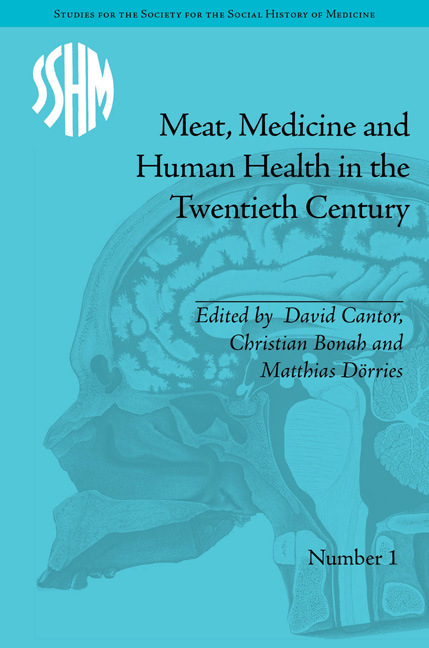Book contents
- Frontmatter
- CONTENTS
- Acknowledgements
- List of Contributors
- List of Figures and Tables
- Introduction
- Part 1 Meat and Therapeutics
- Part II Meat, Politics and Culture
- Part III Meat, Risk and Regulation
- 9 Mad and Coughing Cows: Bovine Tuberculosis, BSE and Health in Twentieth-Century Britain
- 10 Food, Drug and Consumer Regulation: The ‘Meat, DES and Cancer’ Debates in the United States
- Notes
- Index
10 - Food, Drug and Consumer Regulation: The ‘Meat, DES and Cancer’ Debates in the United States
from Part III - Meat, Risk and Regulation
- Frontmatter
- CONTENTS
- Acknowledgements
- List of Contributors
- List of Figures and Tables
- Introduction
- Part 1 Meat and Therapeutics
- Part II Meat, Politics and Culture
- Part III Meat, Risk and Regulation
- 9 Mad and Coughing Cows: Bovine Tuberculosis, BSE and Health in Twentieth-Century Britain
- 10 Food, Drug and Consumer Regulation: The ‘Meat, DES and Cancer’ Debates in the United States
- Notes
- Index
Summary
On 26 April 1973, the Wall Street Journal announced that the Food and Drug Administration (FDA) had just banned diethylstilbestrol (DES) implants in cattle and other livestock, recalling that one year earlier the FDA had already prohibited the use of DES in animal feeds. Cancer was the official motive for this unusual action, which made a food additive that had been used for more than twenty years as a growth enhancer disappear from the agricultural scene. The industrial and economic significance of the event was not as dramatic as the cattle breeders and the animal-food industry thought it would be when they argued against these administrative measures. As the Wall Street Journal failed to point out, other growth-promoting drugs were either already on the market or ready to be introduced as substitutes for DES. The symbolic value of the DES affair should not, however, be underestimated. Controversies over its uses had started fifteen years earlier – as soon as farmers had begun employing DES-enriched premixes – on a massive scale and did not stop with the 1973 ban. The decision was immediately contested in court and even though a federal judge finally approved the FDA ban in 1978, illegal uses of DES remained an issue until the mid-1980s.
The DES affair thus lasted for a quarter of a century. Controversies originating in the use of the substance addressed all concerns connected with the domination of industrial practices in US agriculture.
- Type
- Chapter
- Information
- Meat, Medicine and Human Health in the Twentieth Century , pp. 179 - 202Publisher: Pickering & ChattoFirst published in: 2014



